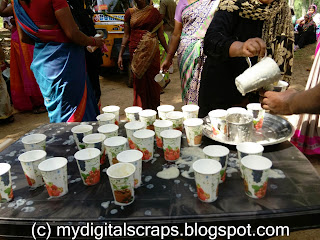Last summer, when in Madurai, we heard about the excavation in Keeladi which was causing ripples to be a Sangam age city site, excavated by the Archaeological Survey of India (ASI).
Just when we were pondering whether it will be possible to see the excavation site, we heard that the DHAN foundation in Madurai, has trips arranged for students and general public interested to learn more about the finding, while the excavation was still underway. The trip was fully guided and informational. The lead archaeologist at that time, professors and experts were also present at the site, to answer questions and provide information.
Keeladi is 12 kms from Madurai in Sivagangai district, south of Vaigai river. The archeologist heading the dig, said that, since it is very hard to find sites to excavate within Madurai, the ASI has been looking on either banks of Vaigai river, through its course, in hopes of finding clues about cities that thrived near Madurai during the Sangam age. Of many sites that they had assessed and dug they have been very lucky in finding this flourishing city that they currently guess through comparative testing that it could be around 3rd century BC, which puts it on Sangam age Pandyan rule timeline. If the carbon dating testing confirms this, it is a pretty exciting find for history enthusiasts and common folk alike.
I really appreciate the ardor shown by
K.P.Bharathi, adviser tourism development at Dhan Foundation, Madurai who arranged this whole trip and seems to be doing much more for local tourism and protection of historical sites, through the foundation.
Details of the dig and the current developments timeline of the excavation has been reported and documented in the newspaper, 'The Hindu'
here.
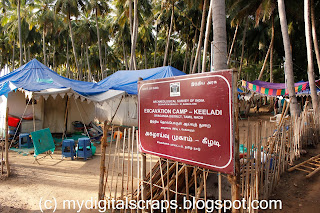 |
| Keeladi Excavation Camp |
 |
| Archaeologists and students camped there during the dig |
 |
| The site is in a privately owned coconut grove |
 |
| K.P.Bharathi, advisor, tourism development, Dhan Foundation, Madurai - talking about the agenda for the day |
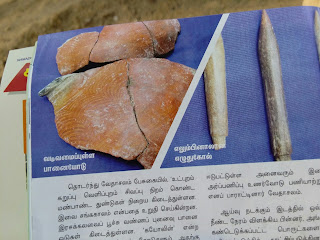 |
| Ornate Potware and bone writing tool |
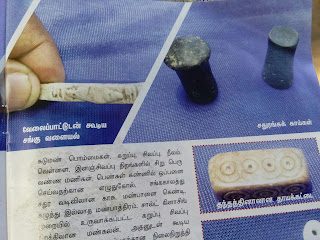 |
| Decorated shell bracelet, Chess pieces, Ivory dice |
They have found more than three thousand artifacts made of stone, terracotta, iron, ivory and bone. Numerous jewelry beads made of terracotta, agate, coral, marble, glass and gold have been found, as well as, decorative bangles and terracotta and ivory earrings.
Writing tools, weapons and game pieces have been found. Pandyan age coins and Roman coins, slabs have been found proving trade relations between them. Sophisticated, ornate pots have been found. Mud pots with Tamil Brahmi inscriptions of names of owners have been found. Tamil, Prakrit, Sanskrit names among them, indicate contacts with other people.
The brick buildings are the highlights of this find, the experts say. There are square and rectangular structures (tubs) made with with brick floors. There are long walls made of bricks also, along these tubs with path ways to walk on them. They have found holes next to these which may have been used to erect poles to build wooden roof structures and they have found brick tiles used to build roofs. These brick roof tiles have holes for iron nails used to hammer them in place. They have also found water canals made with bricks and ring wells near them.
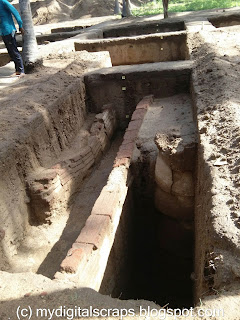 |
| உரை கிணறு (Ring well) |
 |
| 12 layered Ring Well |
 |
| Collected pieces of pots, roof tiles and other items are sorted |
 |
| Brick Tubs |
 |
| Water canals |
 |
| Brick pipelines |
 |
| Furnace and work area |
 |
| Furnace |
 |
| Large pot |
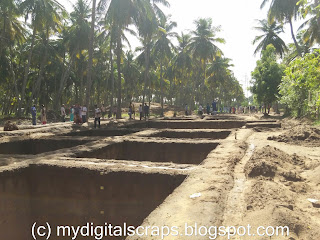 |
| The dig site |
The entire expedition ended with refreshing 'Kambu Koozh' (Pearl millet porridge) served by the local women's club. Yum!
For me, it really was an amazing experience to walk through the ruins of a possible Sangam age city, in its original location, so close to Madurai. It would have been great if they were able to keep the excavated site preserved in its original location. But since it is in a private land, they had to close it and all the artifacts have been moved for further research and preservation in a museum.



















